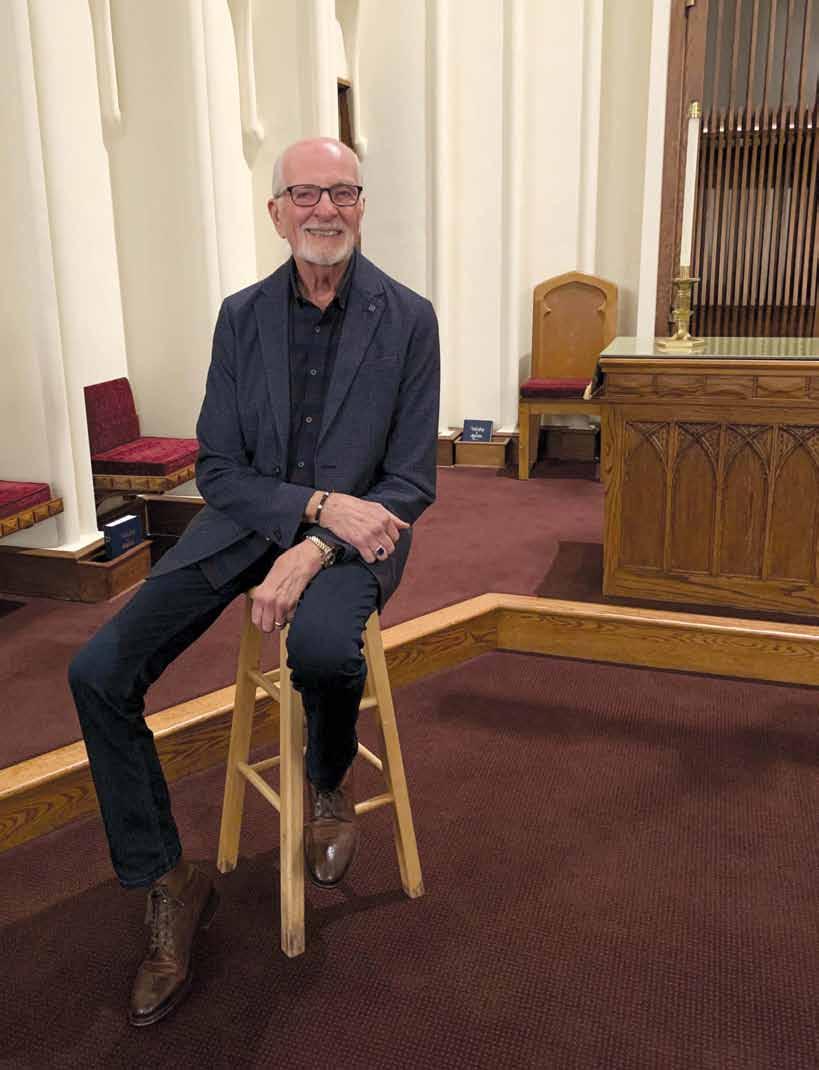
and allows me
do what i love to do, which is to make music.”









and allows me
do what i love to do, which is to make music.”








Seniors are often targeted by criminals. Though many criminals target seniors from afar via telephone or internet scams, criminals seek to enter seniors' homes.
Home security is important for people of all ages, but especially so for seniors and aging individuals living alone. By following certain safety tips and developing a home security plan, seniors can feel safer at home.
Lock windows and doors.
It may seem like common sense, but failure to repeatedly lock windows and doors can, and often does, give burglars easy entry into the home.
Think about a smart doorbell.
Technology now enables doorbells to provide a video feed to a person's smartphone or tablet over WiFi. This allows residents to see who is at the door and speak to this person without having to open the door. Some products like "Ring" will even register motion activity and record short videos from outside of the house.
Don't share or leave keys.
Avoid leaving keys under a mat or in a flower pot. Others may be watching your actions and gain access to your home while you are away.
Ask for ID.
When service people or other individuals come to the door, verify their credentials by asking to see some identification.
Get a home security system.
The best protection against burglars is a home security alarm, states HomeSecurityResource.org. Such an alarm often deters burglars from breaking in.

Install a lockable mailbox.
Locked mailboxes restrict access to sensitive information, such as bank account numbers, sent in the mail. Make sure retirement checks or other payments are deposited directly into bank accounts instead of having them sent by check.
Use home automation.
Home automation, or a "smart home," can be utilized to turn on lights, set the thermostat, lock doors, and much more.


Adopt a dog.
Dogs can be an asset to seniors. Dogs provide companionship and can bark or alert seniors if someone is around or inside of the home. Home security is serious business for seniors who are vulnerable to criminals.
“Movingto eMeadows at MariaJosephwas theright choice for menearly veyearsago. equality of life is enhanced bythe strong senseofcommunity :neighbors helpingneighbors, friendly sta providingenter tainment,exerciseclasses,walking trips, andcaring supportwhenhelpisneeded.” ~Ruth



“I love alltheactivities at MariaJosephManor!!! Especiallythe ice creamtruck!!” ~Mar yAnne
“Shortly a er my husband andI moved intothe Meadows,I realized my husband needed care at Nazareth Memory Center.He hasadaptedsowelland even refers to Nazareth as “home.”I can’t thank everyone enough forallowingustobeapar tofwhatwecall “family.” ~Becky andBirdie

“ esta at Emmanuel Center took such good careof me.One day twogirls came in to helpmeget readyandtheyweresinging asong. Soon,wereall laughingandsinging together.I am so thankful for allthe therapy department didforme.SogladImadethe choice to come to Emmanuel Center.” ~Jessie


Regular visits with a medical professional are an important part of a healthy lifestyle. Too often people visit the doctor only when they are ill, as they may not realize just how essential well visits and physical exams are.
Routine checkups are the smartest way for people in all age groups to stay on top of their health, but they can be especially valuable for those age 50 and older. Regular checkups enable physicians to check current health against past visits, ensuring that any anomalies can be investigated and treated efficiently and promptly. This can make the difference in slowing down the progression of a disease that has already developed or prevent something from becoming a full-fledged issue.
The Mayo Clinic says there are no hard and fast rules about how often seniors should visit health care providers. Those who are in generally good health may only require one medical checkup a year. At this point vital signs will be checked, medications reviewed and lifestyle topics discussed. Doctors may even recommend or discuss tests. Patients also can bring up any issues they may be experiencing, however insignificant they may seem. Anything from sleep disturbances to memory loss to unexplained fatigue or pain can be addressed. Sometimes getting everything out in the open and being reassured that there's nothing to worry about can be helpful.
General care and geriatric doctors also are adept at asking questions to get a sense of how patients are faring in the world. This may include topics that seemingly have no relevance to health but can be quite important. A provider may
ask about topics such as bathing or dressing. Questions about social interaction or typical routines can paint a better picture of both physical and mental health.
The recommended frequency of doctor visits may change as health issues arise or if follow-up is needed after a treatment plan or injury, according to the caregiver company Home Care Assistance. Some seniors may have to visit a provider once a week or once a month. Doctors, nurses and therapists will design a regimen based on a patient's current health needs.
The following are some compelling reasons to be diligent with provider visits.


Frequently health issues can be silent and not noticed




• early on by a patient, according to Mercy Medical Center in Baltimore.

Patients will be less likely to forget about important
• screenings, like mammography, prostate tests, cholesterol tests, and more.



• immunizations to stay healthy.




Vaccines can be administered, as even adults need certain
• on a diet or taking up a new fitness regimen.
Patients can discuss potential lifestyle changes, like going
It is essential to follow through with health care provider visits, even if they seem redundant. Physicians may detect issues that warrant close observation. Patients are urged to have an open dialogue with their doctors so they understand the reason behind health care visits and expectations in the future.
Even musical chords sound like a chorus of angels when the Susquehanna Valley Chorale warms up. The group rehearses every Tuesday under the direction of Dr. Bill Payn, a man whose very name has come to be associated with magnificent music.
It would be easy for Payn, 76, to kick back and rest, but instead he’s at Titan Tactical, in Shamokin Dam, three times a week to walk/ run three miles and work with a trainer.
“I’m conducting major works, standing on a podium for a two-hour rehearsal every week, waving my arms,” Payn said. “Staying fit keeps me healthy. It keeps me alert. It gives me energy and allows me to do what I love to do, which is to make music.”
Payn retired from Bucknell University, in Lewisburg, in 2014 as former chair of the music department and professor of music. His Emmy-nominated Candlelight Christmas production at Bucknell’s Rooke Chapel has been kindling people’s holiday spirit for decades.

Growing up in Ashtabula, Ohio, he was grateful to family and teachers who encouraged him to pursue a career in music. He credits professors at Westminster Choir College, in Princeton, New Jersey, for guiding him.
“Westminster Choir College changed my life,” Payn said, noting he learned from conductors like Leonard Bernstein and Sir Malcolm Sargent. “It was the right place for me.”
After receiving his PhD from West Virginia University in 1981, he applied along with 110 other applicants for a position at Bucknell and was thrilled to be accepted.
StorY & PHotoS: cindY o. Herman“It was kind of serendipitous,” he said. “I had played an organ recital at Rooke Chapel in 1976. I thought, ‘Wow, this would be such a great place to teach.’ I loved what I saw at Bucknell.”
He loved it so much that when he was later offered a position at the prestigious Northwestern University School of Music, he declined.
“I credit Dean Larry Shinn with my staying at Bucknell because he said, ‘Bill, you’re not done here. We need you. The students need you,’” Payn said.
He also realized how much he had grown to appreciate being greeted by name and working with students across campus.
“I always had students who had a passion for singing and wanted to do well even if it was not a main part of their lives,” he said. “To encourage that was amazing. So, 32 years at Bucknell, and I never looked back.”
The students’ energy and passion kept him young.
“I’m very blessed because I have many students who keep in touch,” Payn said, adding with a chuckle, “Lots of Christmas cards.”
The Bucknell Candlelight Christmas service, one of Payn’s most endearing legacies, has been aired on national TV for the past 20 years. Along with the splendor of the students’ voices soaring to the ceiling and softening almost to a whisper, it incorporates brass, harp and organ music with scriptural readings and ends with the Ringing in of Christmas. Payn is touched when people tell him it’s now part of their holiday traditions.
“Of course I am honored that people recognize the excellence I try to impart in my music,” he said. “I think, particularly choral music has a healing connection because it has a text. Seasonal music we’ve sung since childhood can elicit an emotion that allows us to go back to those things that were most important to us. The power of music is amazing.”
He recalled a time when a man who knew he wouldn’t be alive the following Christmas asked to speak with Payn after the performance.
“He just took my hand and thanked me,” Payn said. “Those are special moments.”
Payn continues his Candlelight Christmas at Zion Lutheran Church, in Sunbury, with the Susquehanna Valley Chorale (SVC).
“I decided to bring that tradition to the Valley with the Chorale,” he said. “Zion is a beautiful church.”
When composing anything from handbell compositions to major works, Payn searches for “a beautiful melody” and sometimes wakes at night to dash to the kitchen and write the notes he has heard in his head. He recently finished a major work called “Love” that was premiered by the SVC in October, 2022.
In 1996 he took over as conductor of the SVC, where he values working with community members united by their love of singing.

Adam Dietz, who handles marketing and development there, first met Payn as a high school sophomore when Payn directed district chorus and, under Payn’s advice, attended Westminster Choir College. Working with him in the SVC, Dietz said, is “effortless.”
“He always leads with gentleness and kindness in whatever he does, even outside of the chorale setting,” Dietz said.
“Watch his hands,” said SVC singer Joanna Rees. “There’s emotion on his face; he connects with us. The motion in his hands just pulls it out of us.”
(continued on page 8)
(continued from page 7)
Since retiring from Bucknell, Payn and his wife, Ruth Anderson, love visiting their four children and 11 grandchildren all over the East Coast and St. Thomas in the U.S. Virgin Islands. The pandemic cut into their delight in traveling, but they left recently for a longanticipated trip to Morocco.

Payn plans on conducting the SVC until he turns 80. After that, he and Ruth will continue to travel and attend their grandchildren’s milestone events. They’ll also continue entertaining friends and walking around their Walnut Acres Farm, in Penns Creek.



“We’re not going to sit around,” Payn said. “You just hope you can continue doing what you love to do. I feel very fortunate to be where I am and to be healthy. I don’t plan to get older too soon.”
Cindy O. Herman lives in Snyder County. Email comments to her at CindyOHerman@gmail.com
Dr. Bill Payn conducts the Susquehanna Valley Chorale during an evening rehearsal at the First Baptist Church, in Lewisburg.











n an ideal world, people young and old exercise each day. But as men and women age, finding time to work out is not so easy.
Commitments to work and family often take precedence over daily exercise. As a result, many people 50 and over might not have exercised regularly or at all in many years. But as children grow up or even move out, people facing down their golden years are often compelled to get back in the gym. That's a wise decision that can increase a person's chances of being healthy and happy in retirement. But before beginning a new exercise regimen, men and women over 50 should take heed of the following safety tips to ensure their efforts are not derailed by accident or injury.
Speak with your physician. The National Institute on Aging notes that even people with chronic conditions such as heart disease, diabetes or arthritis can be physically active. However, anyone with such a condition and even those who don't fall into those categories should consult with their physicians and receive a full physical before exercising. Such a consultation and checkup can shed light on any unknown issues, and physicians can offer advice on how to safely manage any problems that may arise.
Begin with low-intensity exercises. Even if you feel great and have maintained a healthy weight, don't push yourself too hard at the start. Your body needs time to adjust to physical activity, so choose lowintensity exercises like walking and light strength training so your muscles, tendons and ligaments can adjust. Initially, exercise every other day so your body has ample time to recover between workouts.
Choose the right places to exercise outdoors. Exercising outside provides the best of both worlds for many people, providing a chance to get healthy all while enjoying the great outdoors. When exercising outdoors, choose areas that are not remote and where others can see you and offer help if you suffer an injury or have an accident. Boardwalks, public parks and outdoor gyms are safer places to work out than wooded areas or other places well off the beaten path.
Stay hydrated. The NIA notes that many people lose their sense of thirst as they age. But just because you aren't thirsty does not mean you don't need water, especially while exercising. Water regulates body temperature and lubricates the joints, thereby decreasing your risk of injury during exercise.
Exercising after 50 can help people live healthy well into retirement. But caution must be exercised when aging men and women return to exercise after a long break.



Nearly every day, I educate clients about Medicare and supplemental coverage. And several times a week, I get calls like this:
I want to know how to get all the Medicare benefits I’m entitled to, like vision, hearing and dental.
Immediately I know the person has been watching TV, and I know which ads they are parroting. So, what are those celebrity-endorsed commercials really about, and should you call them? (Spoiler alert: No!)
In short, the advertisers are fishing for business. They want to sell you a Medicare insurance plan, and guess what? If you buy one from them, you must GIVE UP whatever plan you have now. That is the single most important thing to know about the ads. Once my callers understand that, they aren’t nearly as interested in whatever “extra benefits” the advertiser’s plans may (or may not) provide.
Aren’t the commercials from MEDICARE? No. The Centers for Medicare and Medicaid Services (CMS), the Medicare agency, has nothing to do with the commercials, apart from dictating what the ads can and can’t say. And most

advertisers push that envelope as far as possible to entice you into calling.

The hotlines can’t offer you anything more than local agents can. They generally sell the same plans the rest of us sell. But a common tactic is to lure you with talk of “zero premium” plans that cover everything imaginable…all for free. Sounds too good to be true? Well, there’s a reason for that! Such plans do exist, but they are generally only available to Medicare beneficiaries with extremely low incomes and little savings. When you call, you will likely be told you don’t qualify for the “everything free” plan, but not to worry—they can sell you something else instead. To me, this is classic bait and switch. They lure you into calling with one plan, and often end up selling you another, less attractive option.
Medicare is complicated enough as it is, and these ads are not helpful. If you want to understand your options and make an informed choice, you can do better than calling the hotlines. Start by reading the Medicare & You book that Medicare sends out. Then talk with experts, like your local agency on aging, or any Medicare agent…for FREE. (If they try to charge you, get up and leave). A local meeting with a reputable agent, one that you can reach again if you need to, will almost certainly serve you better than calling a hotline and ending up in whatever plan some random, faceless phone representative feels like selling you.

Growing older may come with some added laugh lines or a few extra aches and pains, but many will attest to the benefits and wisdom earned from a life well-lived. And if that's not enough, the discounts and other perks afforded seniors can make reaching one's golden years a bit easier to embrace.
Every day the list of companies offering special deals for people of a certain age continues to grow. Individuals willing to do the research or simply ask retailers and other businesses about their senior discount policies can be well on their way to saving serious money. Keep in mind that the starting points for age-based discounts vary, with some offering deals to those age 50 and up, and others kicking in at 55 or 60-plus.
The following is a list of some of the discounts that may be available. Confirm eligibility as companies change their policies from time to time. Also, the editors of Consumer World say that the senior discount might not always be the lowest price, so comparison shopping is a must to find out which discount or coupon is the best deal.

amtrak: Travelers age 65 and older can enjoy a 10 percent discount on rail fares on most Amtrak trains. For those who prefer ground travel but want to leave the car at home, this can be a great way to get around.
Fast-food/sit-down restaurants: Establishments like Wendy's, Arby's, Burker King, Denny's, Applebees, Carrabba's Italian Grill, and Friendly's offer various senior discounts. Most are 10 to 15 percent off the meal. Others offer free beverages or an extra perk with purchase.
Kohl's: This popular department store provides a 15 percent
discount every Wednesday to shoppers ages 60-plus. Other stores like Modell's, Belk, Bon-Ton, and SteinMart offer similar discounts.


marriott: Travelers age 62 and older are privy to a 15-percent discount on room rates at Marriott brand hotels, subject to availability.
roto-rooter: Plumbing problems can get expensive, but online sources cite a 10 to 15 percent discount depending on location for this drain cleaning service provider in North America.
national Parks: The U.S. National Parks Service offers steep discounts on the annual pass, which provides entry to more than 2,000 federal recreation sites.
grocery store: Food shopping gets a little easier with discounts at Bi-Lo, Fred Meyer, Gristedes, Harris Teeter, PigglyWiggly, and Publix. Be sure to check with local supermarkets about senior discounts, as they vary, particularly as to what day of the week and for what age they kick in.
aarP membership: It is important to note that many companies require enrollment in AARP for people to get senior discounts. AARP also has its own AARP Prescription Discount Card so that members and families can save around 61 percent on FDA-approved drugs that prescription insurance or Medicare Part D plans fail to cover.
t-mobile: This carrier offers two lines with unlimited talk, text and LTE data for $35 with AutoPay for seniors age 55-plus. Only the primary account holder has to be 55.With a little digging, seniors can find scores of discounts to help them save money while enjoying their golden years.


THis arTiCle was wriTTen by edward JOnes fOr use by sHeri MarsHall, yOur lOC al edward JOnes finanCial advisOr, COurT yard OffiCes, selinsgOve, Pa. edward JOnes, MeMber siPC


In the past year, we’ve seen some big swings in the financial markets. This volatility may make you feel as if you have little control over your investment success. But the truth is, you do have more control than you might think — as long as you don’t let fear guide your decisions.
investment-related fear can manifest itself in a few different ways:
• Fear of loss – Some investors may emphasize avoiding losses more than achieving gains. Consequently, they might build portfolios they consider very low in risk, possibly containing a high percentage of certificates of deposit (CDs) and U.S. Treasury securities. Yet, a highly conservative approach carries its own risk — the risk of not achieving enough growth to stay ahead of inflation, much less meet long-term goals such as a comfortable retirement. To reach these goals, you’ll want to construct a diversified portfolio containing different types of assets and investments — each of which may perform differently at different times. Your objective shouldn’t be to avoid all risk — which is impossible — but to create an investment strategy that accommodates your personal risk tolerance and time horizon.
• Fear of missing out – You’re probably familiar with the term “herd mentality” — the idea that people will follow the lead of others for fear of missing out on something. This behavior is responsible for fads or the sudden emergence of “hot” products, and it’s also relevant to investing. In fact, herd mentality may contribute to sharp jumps in the financial markets as investors drive up prices by buying stocks to avoid being left behind. And the same may be true in reverse — when the market starts dropping, skittish investors may accelerate the decline by selling stocks so they, too, can get out before it’s too late. Buying or selling investments should be considered as needed to help advance your long-term financial strategy — not in response to what others are doing.
• Fear of the unknown – Some investors fall victim to “familiarity bias” — the tendency to invest only in what they know, such as local or domestic companies. But this behavior can lead to under-diversified portfolios. If your portfolio is dominated by just a few investments, and these investments are fairly similar to each other, you could experience some losses when the inevitable market downturn occurs. To help reduce the impact of market
volatility, it’s a good idea to spread your investment dollars across large and small companies in a range of industries and geographical regions. And that’s just on the equities side — it’s also wise to consider further diversifying your portfolio by owning bonds and government securities. (Keep in mind, though, that diversification can’t guarantee profits or protect against all losses.)
• Fear of admitting failure – Some individuals don’t like to admit when they’ve been wrong about something, and they may continue the same failed activities, hoping for eventual success. This behavior can be costly in the investment arena. Sometimes, a particular investment, or even an investment strategy, just doesn’t work out, but an investor is determined to stick with it — even if it ultimately means considerable financial loss. Don’t let his happen to you — if it becomes apparent you need to change your investment approach, move on to something better.
Fear can hold us back in many walks of life — but don’t let it keep you from making appropriate investment moves.
Backyard barbecue season begins in spring and continues through summer and, where the weather allows, into fall. Barbecues are a perfect summertime soiree, as they're usually laid back affairs and make use of the pleasant weather.
While it's fun to expand your culinary horizons over the open flame of a grill, it's important that you never forget the basics, especially when entertaining crowds who are no doubt looking forward to grilled burgers. Giving the masses what they want is good hosting, but you can still try your hand at a little experimentation when serving burgers at your next backyard barbecue. The following recipe for "Herb Cheese-Stuffed Garlic Burgers" provides the best of both worlds.
2 pounds ground beef chuck, 85% lean
2 tablespoons chopped garlic
1/2 teaspoon kosher salt
1/4 teaspoon ground black pepper


3 ablespoons herbed garlic cream cheese, such as Boursin
6 hamburger buns, split Oil for coating grill grate
Using your hands, mix the beef, garlic, 1. salt, and pepper in a bowl until well blended; do not overmix. Using a light touch, form into 12 patties no more than 1/2-inch thick.
Put a portion (about 1 1/2 teaspoons) 2.
of cream cheese in the center of each of the 6 patties; top with the remaining patties and press together, taking care to seal the edges well. Refrigerate the burgers until the grill is ready. Brush the grill grate and coat it with 3. oil. Put the burgers on the grill, cover and cook for 9 minutes, flipping after 5 minutes, for medium-done (150 F, slightly pink). Add a minute per side for well-done (160 F).
To toast the buns, put them cut-sides 4. down directly over the fire for the last minute of cooking.
If serving the burgers directly from the 5. grill, serve on the buns. If the burgers will sit, even for a few minutes, keep the buns and burgers separate until just before eating.

There are many different takes on potato soup, but most classic Irish recipes feature potatoes, stock, leeks, and onions.

Start to finish: 40 minutes (20 minutes active) | Servings: 6
1 tablespoon unsalted butter
1 onion, diced (about 1 1/4 cups)
1 leek, white and light green parts minced (about 1 1/4 cups)
1 celery stalk, diced (about 1/2 cup)
1 garlic clove, minced (about 1/2 teaspoon)
1 quart chicken broth
2 yellow or white potatoes, peeled and diced (about 2 cups)
1 sprig fresh or 1/2 teaspoon dried thyme
2 cups chopped escarole (about 8 ounces)
1 cup diced country ham
1/4 teaspoon salt, or to taste
1/4 teaspoon freshly ground black pepper, or to taste
Heat the butter in a soup pot 1. over low heat. Add the onion, leek, celery, and garlic; stir until they are evenly coated. Cover the pot and cook until the vegetables are tender and translucent, 6 to 8 minutes.
Add the broth, potatoes and 2. thyme. Simmer the soup until the potatoes are tender enough to mash easily, about 20 minutes. Remove the thyme and discard. Puree the soup. Return the soup to the pot and bring to a simmer. Add the escarole and diced ham 3. and simmer, 12 to 15 minutes, or until all the ingredients are tender.
Season with salt and pepper. 4. Serve the soup in heated bowls.
classic recipes to cook, share and enjoy
This recipe for Molten Chocolate Cakes is a mix of spongy cake and warm, flowing custard. Dress up the cakes even further with berries and whipped cream or chocolate shavings.

1 package (6 squares) Baker's Bittersweet Baking Chocolate
10 tablespoons butter


1 1/2 cups powdered sugar
1/2 cup flour
3 whole eggs

3 egg yolks






Grease six custard cups or 1. souffle dishes. Place on baking sheet. Microwave chocolate and 2. butter in a large microwavable bowl on high for 2 minutes or until butter is melted. Stir until chocolate is completely melted. Add powdered sugar and 3. flour; mix well.

Add whole eggs and egg yolks;
4. stir with wire whisk until well blended. Divide batter evenly among 5. prepared custard cups. Bake at 425 F for 14 to 15 6. minutes or until cakes are firm around edges but soft in the centers. Let stand 1 minute. Run small knife around cakes 7. to loosen. Carefully invert cakes onto dessert dishes. Garnish as desired. Serve 8. immediately.
Tip: batter can be made a day ahead; pour into prepared custard cups. Cover with plastic wrap; refrigerate. when ready to serve, uncover and bake as directed.








Leisure activities may be widely viewed as fun ways to fill up free time, but the benefits of leisure activities extend beyond beating boredom. A analysis published in the journal BBA Molecular Basis of Disease found that leisure activities have a positive impact on cognitive function and dementia. After retirement, leisure time constitutes a large part of many retirees' lives, and finding ways to fill that time is more beneficial than merely avoiding boredom. The researchers behind the study concluded that the existing research is insufficient to draw any firm conclusions regarding the effects of certain types of leisure activities on the risk for dementia and cognitive decline, though they did note that multi-domain cognitive training has the potential to improve cognitive function in healthy older adults and slow decline in affected individuals. A multi-domain approach to cognitive training involves memory, reasoning, problem-solving, and map reading, among other activities. Aging adults who embrace activities that require the use of such skills may find that they're not only finding stimulating ways to fill their free time, but increasing their chances of long-term cognitive health as well.





Medicaid is a joint federal and state program available to individuals who meet certain asset requirements that help them pay for long-term care (LTC) costs. Long-term care often creates devastating financial impacts on Americans, particularly the elderly, and for those family members who lose hours of income (and more) while providing care for their loved ones. The Medicaid system is still one of the best options to afford long-term care. Medicaid crisis planning is a strategy that can help you qualify for Medicaid without experiencing financial ruin.
As a joint federal and state social safety net Medicaid differs by eligibility rules and regulations in every state. Unfortunately, people often wait until a catastrophic event brings about sudden illness, disability, or other medical crises before planning long-term care. Under duress, a family system may take advice from misinformed individuals, such as non-attorneys or attorneys who do not practice elder law. Perhaps unwittingly, these people tend to give the worst advice: spend everything you have until you qualify under the Medicaid eligibility rules. Though this approach can work in certain situations, there are far better strategies.
With the help of an elder law attorney, Medicaid crisis
planning allows you to qualify for Medicaid nursing home benefits without spending down all of your life's assets. Working with an elder law attorney to devise a personal Medicaid crisis plan is a logical and financially prudent approach to long-term care and allows you or a loved one to use legally approved strategies to qualify for Medicaid before spending everything you own on the high cost of nursing home care.
If you have a loved one who is either in a nursing home or about to enter a nursing home, that is the time to speak to an elder law attorney. There are legal strategies that allow a person who needs long-term care to divest themselves of some of their assets, and use the rest to pay for their care until Medicaid eligibility is met. The sooner an elder law attorney is employed, the quicker Medicaid eligibility can be met. However, it’s never too late, even if you or a loved one are already in a nursing home.
The level of complexity involved in Medicaid crisis planning deems it necessary to retain an elder law attorney, preferably one specializing in Medicaid planning. Eligibility requirements vary, calculations are complex, timing is crucial, forms are ever-changing, and laws are amended. Call 570-784-4654 to schedule an appointment with a Certified Medicaid Planning Attorney.
RelaxinMontgomery’s onlyrooftoppoolandspa.EscapetotheeleganceofMobile’s historicBattleHouseHotel.ComeexperienceAlabama’s tophotels,resorts,andcoursesalongtheRobert TrentJonesGolf Trail.Stayineightluxuryhotelsandplay26world-classcoursesfromthe TennesseeRivertoMobileBay.Laugh,play,explore,andrelaxinpicturesquesettings.Pamperyourselfinluxuryspas. Teeoffwithfamily andfriends. Walk to areaattractions.Enjoy farm-to-table cuisine. It’s time to planyournext triptothe Robert TrentJonesGolf Trail.



To learnmore, visi t rtjgol f.comor call 800.9 49.4 444. We will behere awai ting your arri val.

Many adults lament that even if they were solid sleepers in their younger years, by the age of 50, their quality of sleep has unraveled. Some cling to the wisdom that people simply do not need as much sleep as they get older. Even though that is partly true, sufficient sleep is still a vital component of a healthy life.
Adults between the ages of 26 and 65 are advised to get seven to nine hours of sleep per evening. However, six hours or 10 hours also may be acceptable. People over the age of 65 need roughly seven to eight hours of sleep each night, though between five and six hours also may be fine. Generally speaking, anything under five hours is not recommended based on data reviewed by sleep experts.
Many older adults do not get enough sleep due to insomnia, states Jack Gardner, MD, a neurologist certified in sleep medicine. They're concerned about health issues, may have sleep apnea, can experience pain or frequent urination, or may be taking medication that impedes sleep. Dr. Leila Kheirandish-Gozal, director of clinical sleep research at the University of Chicago, says that, over time, insufficient sleep can impact metabolism, mood, memory, and heart function.
Various strategies can help people get more sleep and enjoy better sleep quality.


create a luxury bed environment. Splurge on the largest mattress you can afford and one that is comfortable for both parties (if married/coupled). A roomy bed routinely invites sleep. If you have a restless partner, try two separate beds pushed against each other.



consider white noise. The sounds of the house or outdoors may be keeping you up. Many people find that the gentle hum of a fan or a white-noise machine with a calming sound effect makes it easier for them to dose off than complete quiet. It can also block out extraneous noises.



Keep electronics out of the bedroom. It can be challenging to disconnect from electronics, but it is essential to falling asleep. Even a back-lit text coming through in the wee hours can be enough illumination to disrupt sleep.

See your doctor. If medications or illnesses are keeping you up, a change in regimen may provide the relief you need.

Older adults can learn the steps to sleeping more soundly and easily.



Parkinson’s is a complex, progressive, and incurable neurodegenerative disease that can affect almost every part of the body, ranging from how a person moves to how they feel, think, and process. It’s a disease that starts very slowly and results in the accumulation of a protein called alphasynuclein that misfolds within the nerve cells and reduces dopamine-producing nerve cells (neurons) deep inside the brain. Dopamine is a neurotransmitter that helps regulate the body’s movement and initiation of movement. Less dopamine in the brain means less control over movement and less mobility in general.
Parkinson’s is second only to Alzheimer’s as the most common aging disorder of the brain and is more common than multiple sclerosis, muscular dystrophy, and amyotrophic lateral sclerosis (ALS, Lou Gehrig’s disease) combined. Less than 7-8% of cases can be attributed to genetics. Most of the time, people living with Parkinson’s have susceptibility genes that get kick-started by environmental factors, infections, head injuries, and more. That said, there is no single cause of Parkinson’s or predictor of who will get it, and no two people experience Parkinson’s in the same way or along the same timeline. There’s a common saying in the Parkinson’s community that if you’ve seen one person with Parkinson’s, you’ve seen one person with Parkinson’s. Meaning, it’s very possible that we can work with five Parkinson’s athletes, and all of them will present differently.
As early as 10 years ago, doctors told people diagnosed with Parkinson’s to rest and take it easy. Now, with the research we have about the value of exercise for people living with Parkinson’s, physicians are sending their newly diagnosed patients out the door with a prescription to exercise.
Getting started can feel daunting for new people who walk into our facility. Now, add the fact that this person just received a diagnosis of an incurable, degenerative disease that primarily impacts movement, and you can add scared, anxious, frustrated, and uncertain to the mix.
The good news about getting a Parkinson’s diagnosis today is that more treatments exist than ever before. From medications to surgical therapies like deep brain stimulation (DBS), nutrition, exercise, complementary therapies, and more, there are actions people can take every day to live well with Parkinson’s. The big three we’ll focus on here are Medications, Nutrition, and Exercise.
The gold-standard medication for people with Parkinson’s is Carbidopa/Levodopa (C/L). Dopamine agonists are also very common, especially for people who receive their diagnosis at a young age. While knowing about all types of medication is not essential, knowing how C/L works and what it does for people with Parkinson’s is a great start.
The brain’s circuitry damaged in Parkinson’s is called the basal ganglia. Dr. Cherian Karunapuzha from the Meinders Center for Movement Disorders in Oklahoma City likens the circuits to a switch box that codes for our movements. When the thinking part of the brain decides it needs to do something — like reach out for a dumbbell — the planning part of the brain decides to do this and relays the information to the switch box. The switch box then does two things:
I1. t switches on all of the relevant programs needed to kickstart the activity.
I2. t switches off all of the unwanted things that should not be happening while you reach for the dumbbell. For example, you shouldn’t be tremoring, stiff, slow, or rigid when you reach for the dumbbell. When the switch box is working well, an undamaged brain will quickly switch on and off all of the relevant programs and relay that information back to the part of the thinking brain that channels it down your spinal cord/nerves/muscles, and you act out the movement. In Parkinson’s, that circuitry is damaged and inhibits your ability to switch on all of the relevant motor programs in a timely manner. So, what happens? You still do the movement, but it’s in slow motion. Simultaneously, you also can’t shut off things in a timely manner. As a result, a tremor may start, posture may stoop, balance is compromised, etc.
The unique thing about the circuit that’s being damaged is that the nerves that are operating within the circuit require a particular chemical to crosstalk or communicate. That chemical is dopamine. The problem comes because the nerve shooting out dopamine and the nerve receiving dopamine are differentially damaged. This means the one shooting out dopamine gets damaged first, and the one receiving it gets damaged over time. So if you can somehow introduce dopamine from the outside, the nerve receiving the dopamine can be switched on, allowing you to kickstart the circuit again.
Since C/L is external dopamine, most people living with Parkinson’s take it. What’s important to know is that sometimes it doesn’t work.
When someone starts to experience Parkinson’s motor symptoms, there are usually enough healthy nerves that whatever dose of C/L they take, it keeps recycling it; it reabsorbs back into the nerve and then shoots it out, over and over again. In these early stages, they get a pretty smooth effect. The downside is, as their Parkinson’s progresses, their nerves get more and more damaged, and the worse they get at recycling dopamine. The meds get leaked out more easily, and they experience what is referred to as OFF times. OFF times are when Parkinson’s medications aren’t working optimally, and motor and non-motor symptoms aren’t under control. As Parkinson’s progresses, individuals have to take more and more C/L to
manage symptoms, and the window of relief gets shorter and shorter.
It’s important to note that OFF times look different for everyone. For some people with Parkinson’s, OFF means experiencing reduced mobility, increased tremor, muscle cramping, rigidity, slowness, balance issues, stiffness, shortness of breath, and/or swallowing issues. Feeling OFF may also worsen non-motor symptoms and cause fluctuations in cognition, attention, anxiety, depression, and apathy. Being OFF may also cause a person with Parkinson’s to experience increased sweating, lightheadedness, abdominal pain, bloating, urinary issues, visual disturbances, pain, dysesthesia, akathisia, and/or restless legs syndrome.
Many people with Parkinson’s have learned how to time their medication so that when they show up for a ride or exercise class, their meds kick in at the right time to help them get through the workout safely and comfortably. However, OFF times can be unpredictable for various reasons, so while we may have an individual that may be ON the majority of the time, if we see them and their Parkinson’s is more visible than usual, it’s usually because their meds aren’t doing their job. In these cases, it’s important to adapt training to meet them where they are at that moment.
Most people with Parkinson’s have done their fair share of experimenting with different nutritional protocols to see what works best for them and gives them as much symptom relief as possible. There are a couple of things that are important to know regarding the topic of nutrition.
Hydration - Regarding medication, levodopa is not metabolized in the stomach; it’s metabolized in the first part of the intestine. This means anything taken by mouth has to make it to the first part of the intestine to absorb/ work. Therefore, people with Parkinson’s should ALWAYS take their medicine with a full glass of water to flush it down. This is not something all doctors tell their people with Parkinson’s, yet it can be the difference between total symptom relief and none. Drinking water also helps with constipation, which is one of the most common and frustrating symptoms of Parkinson’s. We encourage our athletes to bring water to workouts and to drink throughout.
Protein - Since eating adequate amounts of protein to build lean muscle mass is a key part of most typical nutritional recommendations when related to exercise, it’s important to know that protein interferes with the absorption of levodopa. The amino acids from protein look very similar to levodopa as viewed by the gut. Since the gut has specific channels through which amino acids can be transferred, if our athlete eats a burger patty and then takes their levodopa, their gut can’t filter everything through the gates to the intestine, leading to interference in the absorption of levodopa. This lack of absorption of levodopa can lead to OFF times in many since the protein essentially blocks their meds. Therefore, the best practice for people with Parkinson’s who take C/L is to eat one hour before taking their medications or two hours after taking them, especially regarding protein.
exercise
why People with Parkinson’s MusT exercise
As mentioned earlier, people newly diagnosed with Parkinson’s used to be told to rest and take it easy. Today, doctors who truly understand the disease tell their patients the exact opposite: exercise daily, intensely, and as often as possible. And, if you can, do it with others.
For people with Parkinson’s, regular exercise can:
I
• mprove mobility and coordination
B
• oost mood
R
• educe stiffness and tremor
M
• inimize soreness and fatigue
I
• mprove cognitive function
I
• mprove gait and balance
R
• educe sleep problems
R
• educe postural instability
P
• rovide a critical social outlet
A
• nd it may even slow down the progression of Parkinson’s itself.
“The adverse effects of inactivity include cardiovascular disease, osteoporosis, insomnia, cognitive decline, depression, constipation, and all lead to early mortality. All of these are risk factors when you have Parkinson’s, so if you are both inactive and have Parkinson’s, your risk of early mortality is higher.” – Professor Bas Bloem, Medical Director and Neurologist at the Parkinson Center, Nijmegen, Netherlands
The recommended guideline for people with Parkinson’s to experience the benefits of exercise is to engage in a minimum of 150 minutes of moderate physical activity per week or 75 minutes if it’s high-intensity exercise. That said, here are a few things to keep in mind for Parkinson’s athletes:
Something is always better than nothing. If you come into the gym but are feeling OFF, are moving slowly, and didn’t sleep the night before, any movement you do for that hour is a victory.
High-intensity exercise (or ~80% of max heart rate) is better than slow and low. When it’s safe for you to do so, you will get more bang for your buck as the intensity rises.
You will likely reach the “too much exercise” threshold before your non-Parkinson’s peers will. The worst thing that can happen to someone with Parkinson’s is they get too tired or too hurt to exercise. We challenge our athletes to reach their volume, intensity, and strength goals but work with them to reach the level that’s optimal for the day they’re having.
Based on these recommendations and the fact that endurance, strength, intensity, and balance are critical domains for people with Parkinson’s to concentrate on to help with their motor and non-motor symptoms, exercise can be magic.
PWR!Moves was created by neuroscientist and Parkinson’s exercise specialist Rebecca Farley of Phoenix, Arizona. The program is structured around four foundational elements of exercise to counteract bradykinesia, rigidity and incoordination that interfere with everyday mobility. The classes are designed to help people at all stages of Parkinson’s disease using PWR!Up to reduce falls and step bigger, PWR!Rock for weight shifting and to widen base of support, PWR!Twist using trunk rotation to (continued on page 22)
(continued from page 21)
reduce rigidity, and PWR!Step to improve transitions and balance. In this program, we also work on cognition, voice activation, and activities of daily living.
rock Steady Boxing


neuroplasticity
According to Mike Studer, a physical therapist who specializes in working with people with Parkinson’s, the main reason for prescribing exercise for people with Parkinson’s is so they can take action to slow the disease process, preserve what they have, and make connections that are often left off the table because of learned nonuse.
Learned nonuse happens when a person gets a diagnosis of Parkinson’s, and because of the stories they start telling themselves, they stop engaging in life. They stop taking 10,000+ steps daily, climbing stairs, trying to
balance without a walker, etc. They deem themselves “sick” or incapable, and pretty soon, they are. If they don’t challenge those facets of endurance, strength, and balance, neuroplasticity gets left on the table.
Falling, exercise, and Parkinson’s


The most common reason people with Parkinson’s are admitted to the hospital is due to falls.
Falls are a significant cause of disability, loss of independence, and reduced quality of life for people with Parkinson’s. Approximately 45-65% of people with Parkinson’s fall annually, and 50-85% fall regularly. Falling can lead to fear of falling, which limits their desire to be active and impacts their ability to mitigate symptoms with exercise, restricting activities of daily living (ADLs), resulting in learned nonuse, and higher levels of injuries.
Think about all of the things we draw on in those split seconds before a fall:

•PWR! UP -antigravityextension
•PWR! ROCK -weightshifting
•PWR!TWIST -axialmobility

•PWR! STEP -transitionalmovement training
R
• eaction speed
C
• ognitive processing ability
F

• lexibility
P
• ain-free range of motion
• trength to stop your body’s momentum
S
• ower – generating force fast
P
The good news is that every exercise aspect of either PWR!Moves or Rock Steady Boxing addresses the above and can play a role in helping prevent falls or make them less severe when they do happen.
So… you have Parkinson’s disease. “now what?” now is the time to fight back.
SHAMOKIN DAM, PA 17876
CindyMurphy, NSCA, CPT Certi edinPWR!Moves, Pedalingfor Parkinson’s andRockSteadyBoxingcoach cindy@titantactical tness.com 570-765-0706or570-412-3286


Anon-contactboxing
BoxingClassesareheld Tues.andThurs.





